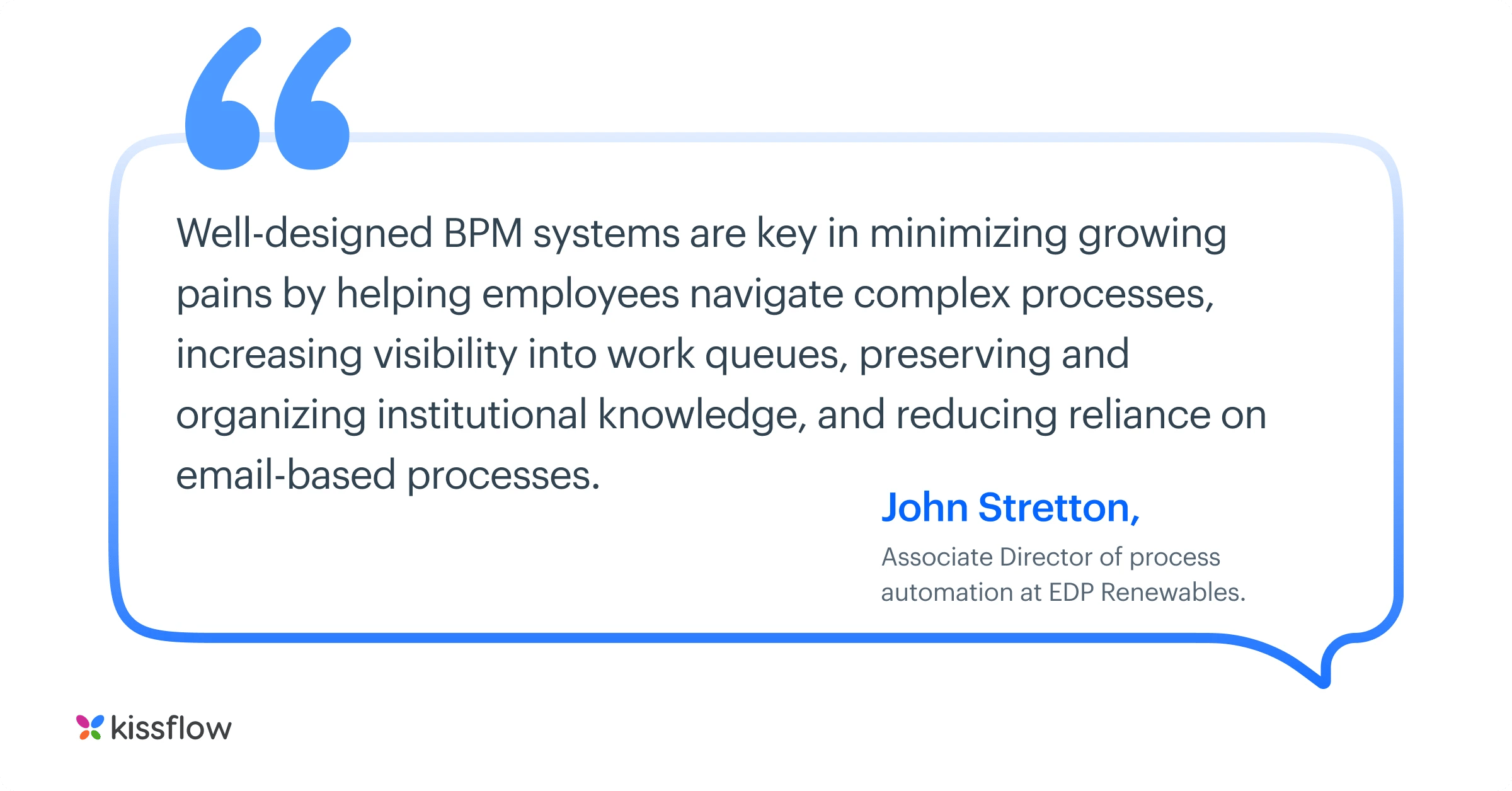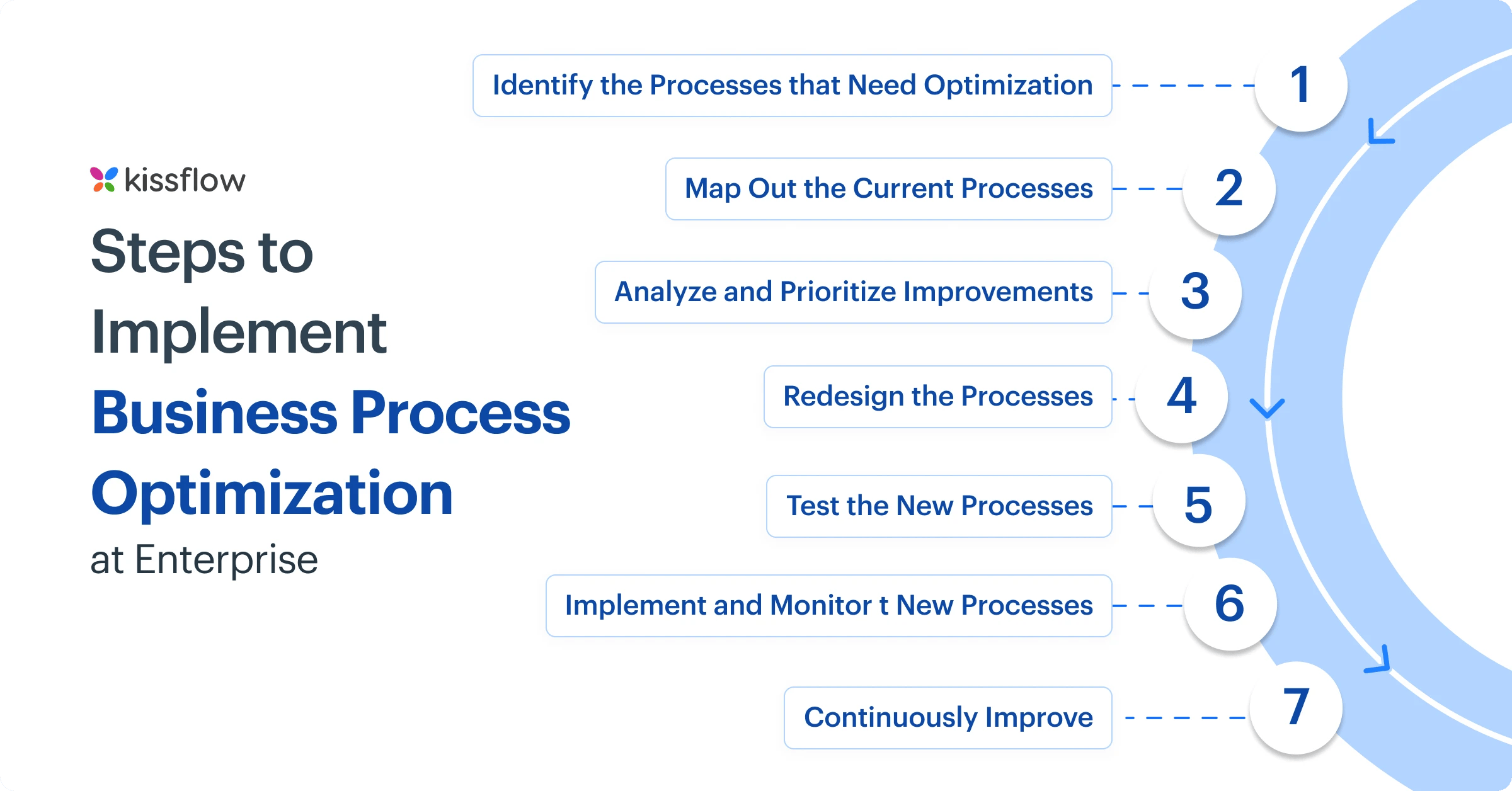
- >
- BPM Software >
- Ultimate Guide on Business Process Optimization For 2026
Ultimate Guide on Business Process Optimization For 2026
When your board asks why operational costs keep rising despite all those automation investments, or when customer satisfaction scores drop even after implementing "efficiency improvements," you're facing the reality that adding technology to broken processes only creates expensive broken processes. As a technology leader, you understand that true optimization requires surgical precision—knowing exactly where inefficiencies exist and how to eliminate them without disrupting critical operations. Gartner's 2024 Business Process Excellence Report reveals that organizations with structured optimization programs achieve 35 percent cost reduction and 50 percent faster cycle times within 18 months.
What is Process Optimization?
A business process optimization strategy focuses on refining workflows to improve efficiency, reduce costs, and increase throughput without breaching operational constraints. It involves structured adjustments to existing processes based on clearly defined goals and measurable outcomes.
This approach plays a critical role in enterprise decision-making, especially when teams aim to simplify operations, reduce redundancies, and increase responsiveness. Adopting a well-structured process optimization software solution allows organizations to tackle inefficiencies at scale—without increasing IT dependency.
What is Business Process Optimization?
Business process optimization is the strategic methodology of enhancing existing workflows through data analysis, automation, and systematic improvement techniques to maximize operational efficiency, reduce costs, and eliminate waste while maintaining or improving service quality and compliance standards.

The Benefits of Business Process Optimization
In the business world, time is money. Any process that can save time, reduce errors, and increase productivity is worth pursuing. Business process Management is reviewing and improving how work is done to achieve these goals. It can be challenging to change established processes, but the benefits are worth the effort.
Optimized processes allow businesses to operate more efficiently, provide better service, and increase profits. Optimizing your processes in this age of competition and digital disruption can help your organization stay ahead of the curve.
Let’s look at some specific benefits:
-
Identifying and eliminating bottlenecks or redundancies in processes, resulting in improved process outputs
-
Improving collaboration and connections between core, strategic, and management processes, leading to better outcomes and increased productivity
-
Streamlining activities to improve process efficiency and productivity, resulting in increased time, resource, and financial savings
-
Reducing risk by avoiding errors and reworking through better process management improves the overall quality of outputs and outcomes.
-
Helping organizations stay competitive by enabling them to run more smoothly and deliver better results in a dynamic and evolving market
How to Implement Business Process Optimization at Enterprise?

Implementing business process optimization requires a systematic approach. Here are some steps you can take to get started:
Step 1: Identify The Processes That Need Optimization
Review your current processes to identify the ones that need improvement. Analyze metrics such as cycle time, error rate, and customer feedback.
Step 2: Map Out The Current Processes
Map out the current processes to understand the steps, inputs, and outputs. Identify inefficiencies, redundancies, and bottlenecks.
Step 3: Analyze and Prioritize Improvements
Analyze the processes to identify areas that can be improved. Prioritize the improvements based on their potential impact, feasibility, and cost.
Step 4: Redesign The Processes
Redesign the processes to incorporate the improvements. Change the sequence of steps, automate tasks, or eliminate redundancies.
Step 5: Test The New Processes
Test the redesigned processes to ensure they are effective and efficient. Plot the new process with a small team or department.
Step 6: Implement and Monitor The New Processes
Implement the new processes across the organization and monitor their effectiveness. Collect feedback and track metrics to assess their impact on efficiency, productivity, quality, and customer satisfaction.
Step 7: Continuously Improve
Review and improve the processes to ensure they remain effective and efficient. Monitor metrics, collect feedback, and make necessary adjustments.
Business Process Optimization Examples
Because optimizing business process is one of the steps in the wider application of BPM platform, it often gets mixed up with other concepts like business process improvement or business process automation.
Here are a few real-life examples of how business process optimization can increase efficiency.
1. Purchase Orders
Multiple purchase orders clog the queue of the purchasing department. The department senses this problem is due to email approvals. To streamline requests, the department deploys a dedicated workflow management system. The workflow system lets employees choose the item and send it for approvals automatically.
2. Travel Reimbursement
The finance department makes frequent errors when reimbursing expenses. Since the entire process is paper-based, they misread numbers and reimburse the wrong amount to employees. To fix this, the department moved to a digital system where employees fill the amount in form fields. There are no processing errors this way.
3. Employee Onboarding
Onboarding a new employee happens in a sequence of steps. The HR executives send the employee agreement over email. After the employee signs it, the next step to provision assets in IT should proceed. But each time HR manually sends a mail to IT to provision laptops and grant access to BPM tools. To make the process faster, an email trigger is set up. Once the employee signs and sends the employee agreement, an email is automatically sent to IT.
How Kissflow Workflow Platform Optimizes Your Business Processes
Kissflow helps organizations streamline and automate workflows. With Kissflow, businesses can digitize their manual processes, automate tasks, and standardize their workflows to improve efficiency and reduce costs. As a robust process optimization software, Kissflow offers an intuitive interface and a drag-and-drop form builder, making it easy for businesses to create custom workflows without requiring any coding expertise.
Kissflow is a workflow automation platform that can optimize your business processes in several ways:
1. Automating Manual Tasks
A key element of any business process optimization strategy is reducing reliance on manual effort. Kissflow automates repetitive tasks like data entry, approvals, and notifications—cutting down on errors and saving valuable time.
2. Standardizing Processes
Kissflow can help to standardize processes by providing a consistent framework for tasks and approvals. You can reduce variation and improve consistency.
3. Improving Collaboration
Kissflow can improve collaboration between departments by providing a centralized platform for task management and communication. You can improve communication and reduce delays.
4. Streamlining Workflows
Kissflow can streamline workflows by eliminating unnecessary steps and reducing bottlenecks. You can improve efficiency and reduce costs.
5. Providing Real-Time Insights
A business process optimization strategy needs data to drive improvement. Kissflow offers real-time visibility into workflow performance, helping teams pinpoint inefficiencies and refine processes continuously.
6. Integrating With Other Tools
Kissflow can integrate with other tools, such as CRMs, ERPs, and HR systems, to streamline processes and improve data accuracy.
Optimize your processes with Kissflow
Optimizing business processes is not just a task but a strategic commitment. It involves continuously seeking ways to improve efficiency and productivity, a mission that every CIO is familiar with. Implementing the right process automation software helps organizations streamline repetitive workflows, minimize errors, and free up teams to focus on strategic initiatives. It creates consistency and efficiency across everyday business operations.
In this digital era, tools like Kissflow are pivotal in this endeavor. With its user-friendly low-code platform interface, robust features, and value for money, Kissflow helps businesses streamline their processes, enhancing productivity, saving time, and ensuring accountability. It's more than just a tool; it's a catalyst for transformation.
Solve your workflow challenges with Kissflow Platform and optimize your team's productivity.
Whether a company is steeped in tradition or just starting, the path to success invariably involves the relentless pursuit of process optimization. And with solutions like Kissflow, this journey becomes possible but also manageable and rewarding.
FAQs - Business Process Optimization
1. What is process optimization?
Process optimization is the systematic practice of enhancing business workflows to increase efficiency, reduce waste, and meet organizational goals more effectively. It involves analyzing existing processes to identify delays, redundancies, or unnecessary steps, and then restructuring them for better performance. This approach ensures that each part of the workflow contributes to overall operational efficiency.
2. What are the benefits of process optimization?
Organizations that invest in process optimization benefit from improved efficiency, reduced operational costs, and greater accuracy in task execution. By simplifying complex workflows and eliminating manual interventions, businesses can accelerate turnaround times and deliver more consistent outcomes. It also supports better compliance with internal standards and helps employees focus on higher-value work, improving overall productivity.
3. What is the difference between process optimization and process improvement?
While both aim to enhance workflow performance, process improvement is typically a reactive approach that addresses specific issues or inefficiencies. It focuses on incremental changes. In contrast, process optimization is a more strategic and proactive discipline. It involves a comprehensive review of processes with the goal of redesigning them to align with broader business objectives, often using automation and data-driven analysis.
4. What are process optimization tools?
Process optimization tools are software solutions designed to help businesses analyze, automate, and refine workflows. These tools provide features such as process mapping, real-time monitoring, and performance analytics, enabling teams to make informed decisions and adjust operations as needed. Platforms like Kissflow offer intuitive interfaces that let users build and optimize workflows without coding, making it easier to manage and improve processes at scale.
5. What is a process optimization strategy?
A business process optimization strategy is a structured plan that guides how an organization will refine its workflows to achieve better outcomes. It involves setting measurable goals, evaluating existing processes, and implementing changes that support efficiency and consistency. This strategy often includes automation, standardization, and real-time data analysis to ensure continuous improvement. By following a clear strategy, businesses can manage complexity, reduce costs, and respond more effectively to operational demands.
6. What strategies improve business process efficiency?
Key strategies to improve business process efficiency include process mapping to identify bottlenecks, automating repetitive tasks, implementing standardized workflows, breaking down departmental silos, leveraging data analytics for informed decisions, and continuous monitoring with regular performance reviews. Employee involvement in improvement initiatives ensures practical solutions that address real operational challenges.
7. How does AI contribute to business process optimization?
AI contributes to business process optimization by identifying patterns and inefficiencies in process data that humans might miss. Machine learning analyzes historical process performance to predict bottlenecks before they occur. Natural language processing extracts insights from unstructured data like customer communications. AI-powered decision engines handle complex rule evaluation, while intelligent automation tackles increasingly sophisticated tasks.
8. What are common challenges in optimizing business workflows?
Common challenges in optimizing business workflows include resistance to change from employees comfortable with existing processes, difficulty aligning cross-departmental processes with competing priorities, legacy system integration limitations, data quality issues that undermine automation effectiveness, lack of process standardization across locations, and insufficient metrics to measure improvement impact.
9. What industries focus most on process optimization?
Industries focusing most on process optimization include manufacturing implementing lean methodologies, healthcare improving patient journeys and resource utilization, financial services streamlining transaction processing, logistics optimizing supply chain operations, and telecommunications enhancing service delivery processes. Regulated industries particularly benefit from process optimization that improves compliance while reducing costs.
10. What tools help businesses improve operations?
Tools helping businesses improve operations include process mining platforms that automatically discover inefficiencies from system logs, workflow automation solutions for streamlining repetitive tasks, advanced analytics dashboards providing real-time performance insights, collaboration platforms that reduce communication barriers, and AI-powered decision support systems that enhance human judgment with data-driven recommendations.
Streamline your workflows and optimize your business processes with Kissflow
Related Articles











%20(1)%20(1).png?width=1997&height=1800&name=The%20ultimate%20buyers%20guide%20to%20BPM%20(1)%20(1)%20(1).png)
